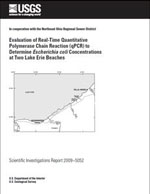During the recreational seasons of 2006 and 2007, the quantitative polymerase chain reaction (qPCR) method was used to determine Escherichia coli (E. coli) concentrations in samples from two Lake Erie beaches. Results from the qPCR method were compared to those obtained by traditional culturing on modified mTEC agar. Regression analysis showed strong, statistically significant correlations between results from the two methods for both years. Correlation coefficients at Edgewater and Villa Angela Beaches were 0.626 and 0.789 for 2006 and 0.667 and 0.829 for 2007, respectively. Linear regression analyses were done to determine how well E. coli concentrations could have been predicted from qPCR results. These hypothetical predictions were compared to the current practice of determining recreational water quality from E. coli concentrations determined for samples collected on the previous day. The qPCR method resulted in a greater percentage of correct predictions of water-quality exceedances than the current method for both beaches and both years. However, because regression equations differed somewhat between both sites and both years, the study did not result in any single relation reliable enough to use for actual real-time prediction of water-quality exceedances for either beach; therefore, a posterior analysis of data was done. Additional years of data may be needed to develop such a relation. Results from this study support the continued development and testing of a qPCR method for providing rapid and accurate estimates of E. coli concentrations for monitoring recreational water quality.


